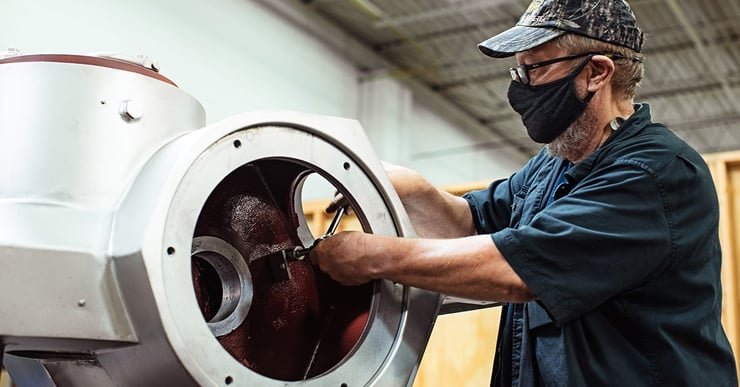Centrifuge equipment failure is an abrupt and hazardous event that can halt your operations at a moment’s notice. While this equipment failure may seem sudden, there are a few telltale signs that something in your centrifuge is not working the way it should.
To avoid costly downtime and repairs, keep your eyes peeled for these four warning signs that your centrifuge may need a little extra TLC.
1. Hazardous Vibrations
With high-speed equipment like centrifuges, it’s impossible to avoid small vibration levels. Maintaining a 2 mm/sec range is a healthy level for most bowl assemblies. However, if a centrifuge reaches higher levels of vibrations than this, there may be a major mechanical issue at hand.
There are a few main causes of vibrations in centrifuges:
- Failure in the drive motor overall
- An uneven foundation for the centrifuge, leading to offsets in the equipment's motion
- An imbalance on the centrifuge itself from particulate matter or wear on the inside
If your system is off-balance, you’ll be able to tell from the vibration sensor.
Be on the lookout for two main benchmarks of dangerous vibration levels. Alarm stage one is 7mm/sec, where the imbalance can cause significant galling and damage on the inside of the equipment. But once the vibration sensor hits alarm stage two at 9mm/sec, shut the system off immediately and service the equipment as soon as possible. Otherwise, you risk large-scale equipment failure that can halt your operations and lead to catastrophic disasters.
2. Unusual Noise Levels
Industrial centrifuges move large loads at high speeds, so if there’s a problem, you’ll probably be able to hear it. Between imbalances and parts that don’t fit, centrifuges aren’t shy: they tend to make distinct and unusual noises when something is wrong.
If your centrifuge is getting louder and louder during operation, that’s normally a sign of an imbalance, which you can check with the vibration sensor.
However, while it might be hard to spot in the mechanical cacophony of a processing plant, irregular noises can indicate another problem entirely.
Try to isolate the centrifuge as much as possible and have your operators listen for sounds they wouldn’t normally hear from the equipment. A grinding or clunking sound can mean mechanical distress. If that’s the case, stop the centrifuge immediately to prevent further damage and potential equipment failure.
Vibration levels and noise levels account for roughly 80% of centrifuge problems you’ll come across during your centrifuge preventative maintenance checklist, so keep a close eye (and ear) on these during production.
3. Insufficient Discharge
With self-cleaning models of centrifuges, an operating water supply flushes out particulate matter and sludge from the inside after each use. This CIP protocol ensures that the bowl keeps its balance, and prevents cross-contamination during operation. However, sometimes it isn’t able to flush the water out correctly.
When centrifuges discharge, they demand water from supply lines. However, depending on your water hardness, calcium and sludge can build up in these lines and make them difficult to clean out. If your discharge isn’t coming out properly, your centrifuge needs some maintenance.
If there’s an issue with the discharge, then the water pressure of the equipment will be at lower levels than normal. The result? A dirty bowl. This can cause products to stick to the sides of the bowl with the excess sludge after every use, leading to issues of cross-contamination and vibrations.
4. Inefficient CIP Process
When self-cleaning centrifuges go through CIP processes and the higher flow rate stays at sufficient levels, it doesn’t always mean the centrifuge will fully clean itself.
Despite the convenience of not having to take apart your centrifuge, sometimes there can be issues with the cleaning mechanism itself.
This can be hard to notice since the cleaning mechanism is on the inside of the equipment, but luckily, there’s an easy way to spot an inefficient CIP process.
When your self-cleaning centrifuge doesn’t have the right tools to clean, there will be significant spore counts (bacteria levels) in your product. Depending on your application, this can lead to chemical imbalances and cross-contamination in food processing.
A simple lab test can give you the results quickly, and if bacteria levels are on the rise, it’s definitely time to do a health check on your equipment.
If you notice any of these signs, it’s time to call the pros.
Centrifuges are volatile equipment that can break down without the right upkeep and maintenance. By the time telltale signs show up, your equipment may already be damaged, leading to expensive repairs or replacement.
The sooner you invest in a consistent centrifuge maintenance schedule, the more confident you can be that you’re maximizing the lifespan of your equipment.
Don’t wait until a preventable issue causes a costly shut-down. Call the experts at Separators Inc. today and address centrifuge damage before it becomes a problem.

